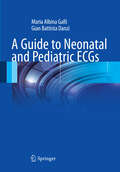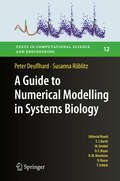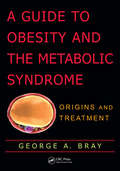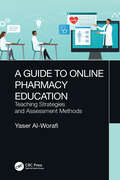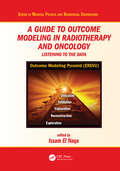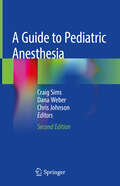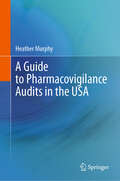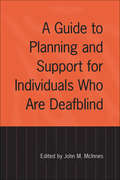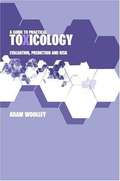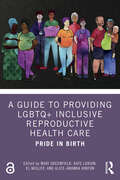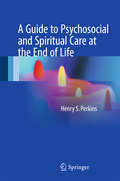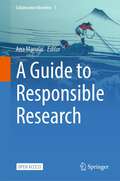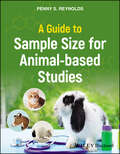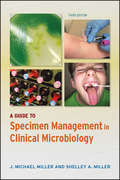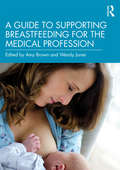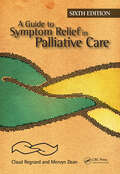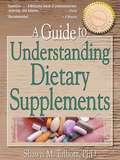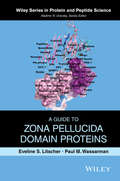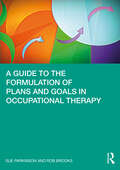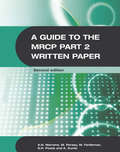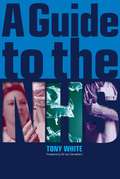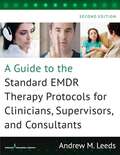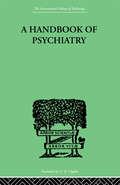- Table View
- List View
A Guide to Neonatal and Pediatric ECGs
by Gian Battista Danzi Maria Albina GalliElectrocardiography has an ever-expanding role in pediatric cardiology evaluation. The specific competencies required for its optimal use in this setting, however, generally lie beyond the expertise of cardiologists used to dealing with adults. This guide - the product of extensive practical experience in the field of pediatric cardiology - proposes a very simple method for reading neonatal and pediatric ECGs that is based on the application of straightforward criteria and permits the immediate recognition of normal and pathological patterns. The first part of the guide presents and describes this methodology and the parameters of normal pediatric ECGs, while the second part focuses on specific pediatric anomalies. More than 150 ECGs displaying both normal and pathologic findings are included, all of which have been collected from clinical practice and analyzed using the proposed method. This book will be an invaluable reference tool for all cardiologists who deal with newborns and children.
A Guide to Numerical Modelling in Systems Biology (Texts in Computational Science and Engineering #12)
by Peter Deuflhard Susanna RöblitzThis book is intended for students of computational systems biology with only a limited background in mathematics. Typical books on systems biology merely mention algorithmic approaches, but without offering a deeper understanding. On the other hand, mathematical books are typically unreadable for computational biologists. The authors of the present book have worked hard to fill this gap. The result is not a book on systems biology, but on computational methods in systems biology. This book originated from courses taught by the authors at Freie Universität Berlin. The guiding idea of the courses was to convey those mathematical insights that are indispensable for systems biology, teaching the necessary mathematical prerequisites by means of many illustrative examples and without any theorems. The three chapters cover the mathematical modelling of biochemical and physiological processes, numerical simulation of the dynamics of biological networks and identification of model parameters by means of comparisons with real data. Throughout the text, the strengths and weaknesses of numerical algorithms with respect to various systems biological issues are discussed. Web addresses for downloading the corresponding software are also included.
A Guide to Obesity and the Metabolic Syndrome: Origins and Treatment
by George A. BrayIn the historical record there is abundant evidence that obesity was a medical and health concern as long as medicine has been practiced. The idea of diet and exercise are bulwarks in the fight against obesity in history from the time of Hippocrates to the 16th century-a span of 2,000 years. Examining the history and etiology of the obesity epidemic, this book discusses various requirements of effective intervention and treatment strategies. The first section covers the history of obesity, defines and evaluates the clinical presentation of the pathology, discusses its prevalence in the population, and explains common analytical measurements. Chapters include genetics and genetic factors, modern consequences of obesity, and quality of life issues. The second section introduces prevention strategies in children and adults, such as dietary and lifestyle changes, medication, and surgical interventions.
A Guide to Online Pharmacy Education: Teaching Strategies and Assessment Methods
by Yaser Al-WorafiThis book describes in detail the various teaching strategies and assessment methods used in pharmacy education. Included in the text is both the advantages and disadvantages of each teaching and assessment method, as well as tips for effective implementation of the strategies. The text covers a plethora of teaching styles, from web based and online learning to lecture and team-based learning, and highlights some of the best practices used worldwide. This book aims to be a valuable single resource for pharmacy educators, students, and researchers. Key features One resource for the pharmacy educators, students, partitioners, researchers, policy makers and other readers with the necessary information and practical guidelines about the online pharmacy education, practice, and research. Describe and discuss the situation of the online pharmacy education, practice, and research around the world. Describe the challenges facing the online pharmacy education, practice, and research and suggest recommendations to overcome the challenges. Describe the pharmacy education teaching strategies and assessment methods. Describe the advantages and disadvantages of each teaching strategy and assessment method. Provide tips for the effective implementation of teaching strategies and assessment methods based on the best practices worldwide.
A Guide to Outcome Modeling In Radiotherapy and Oncology: Listening to the Data (Series in Medical Physics and Biomedical Engineering)
by Issam El NaqaThis book explores outcome modeling in cancer from a data-centric perspective to enable a better understanding of complex treatment response, to guide the design of advanced clinical trials, and to aid personalized patient care and improve their quality of life. It contains coverage of the relevant data sources available for model construction (panomics), ranging from clinical or preclinical resources to basic patient and treatment characteristics, medical imaging (radiomics), and molecular biological markers such as those involved in genomics, proteomics and metabolomics. It also includes discussions on the varying methodologies for predictive model building with analytical and data-driven approaches. This book is primarily intended to act as a tutorial for newcomers to the field of outcome modeling, as it includes in-depth how-to recipes on modeling artistry while providing sufficient instruction on how such models can approximate the physical and biological realities of clinical treatment. The book will also be of value to seasoned practitioners as a reference on the varying aspects of outcome modeling and their current applications. Features: Covers top-down approaches applying statistical, machine learning, and big data analytics and bottom-up approaches using first principles and multi-scale techniques, including numerical simulations based on Monte Carlo and automata techniques Provides an overview of the available software tools and resources for outcome model development and evaluation, and includes hands-on detailed examples throughout Presents a diverse selection of the common applications of outcome modeling in a wide variety of areas: treatment planning in radiotherapy, chemotherapy and immunotherapy, utility-based and biomarker applications, particle therapy modeling, oncological surgery, and the design of adaptive and SMART clinical trials
A Guide to Pediatric Anesthesia
by Chris Johnson Craig Sims Dana WeberThe second edition of the successful book "Your Guide to Pediatric Anesthesia" offers a practical approach to pediatric anesthesia with a concise account of the topic in a reader-friendly format. The book begins with an overview of pediatric anesthesia then continues with chapters related to different pediatric surgeries and the relevant anesthetic issues, including a chapter of emergency scenarios in pediatric anesthesia. The final section has chapters containing past exam questions in pediatric anesthesia, a set of clinical scenarios written in an exam question and answer format, and a glossary of syndromes and conditions with brief, important information and practical recommendations. The book also includes an accurate and comprehensive index which helps readers guide themselves through the book. Written in a consistent, exam-focused, non-academic writing style, chapters provide a clear explanation of each topic with a review of management options, discussing advantages and disadvantages, and concluding with a suggested practical approach in each case. It contains the syllabus for the College exams, but is also full of practical techniques and discussion for trainees during their pediatric rotation. It is relevant and useful for anesthetists who have completed their exams and are now caring for children in their practice. A Guide to Pediatric Anesthesia covers the important topics at a level suitable for trainees, occasional pediatric anesthetists and anesthetic assistants.
A Guide to Pharmacovigilance Audits in the USA
by Heather MurphyPharmacovigilance Audits are an important and growing requirement for Pharmaceutical/BioTech companies. A niche skillset combined with an understanding of audit principles and pharmacovigilance operational and regulatory knowledge are required to effectively conduct these audits This book provides practical guidance to auditors as to what questions to ask, what information to look for, and what documents to request to ensure the auditee Pharmacovigilance System is compliant with regulations, contractual requirements, and industry best practice. The scope is limited to the requirements based on the US Food and Drug Administration (FDA) Regulations. This is an ideal book for auditors and auditees who want to obtain practical PV auditing skills to use within the BioTechnology/Pharmaceutical Industry in the USA.
A Guide to Planning and Support for Individuals Who Are Deafblind
by John McinnesIn this ground-breaking collection, leading experts in the field address the problems of parents, intervenors, and professionals who work with people who have been deafblind since birth or from a very early age. Individuals who are congenitally deafblind face the same challenges as those who become deafblind later in life, but they have not had the same opportunity to develop the communications skills and a conceptual base needed to construct an understanding of the world. The contributors address identification of deafblindness, planning and intervention, development, family support, and education.Just as McInnes and Treffry's "Deafblind Infants and Children" helped to change the approach to and the perception of deafblind children, this collection will assist in fostering a new approach to the education of and support for older children, youth and adults who are deafblind. An essential part of this process is to set forth standards for program development, implementation, and evaluation, which this volume aims to accomplish. It will make an essential contribution to the expanding field of services for the deafblind population of all ages, and to the improved understanding of parents, family members, and professionals who support them.
A Guide to Practical Toxicology: Evaluation, Prediction and Risk
by Adam WoolleyAn experienced toxicologist researcher and consultant provides an overview of toxicology for practicing toxicologists and students in the field, with 15 chapters addressing topics from the necessity of measurement and definitions and maintenance of normality to larger issues of risk assessment and management in the workplace and environment and the future of toxicity testing. Pedagogical tools include text boxes with necessary background information; tables and case studies; and study design and interpretation. Annotation ©2004 Book News, Inc., Portland, OR (booknews.com)
A Guide to Providing LGBTQ+ Inclusive Reproductive Health Care: Pride in Birth
by Mari Greenfield Kate Luxion El Molloy Alice-Amanda HintonThis evidence-based guide brings together a wide range of information and practical tools for midwives, obstetricians, nurses, health visitors and birthworkers, empowering them to provide safe and compassionate care throughout the reproductive journeys of lesbian, gay, bisexual, transgender and queer (LGBTQ+) people. This book may also be helpful to LGBTQ+ people in their own reproductive journeys.Throughout history, in cultures around the world, LGBTQ+ people have become pregnant, sought abortion care, miscarried, experienced infertility, given birth, and made decisions about infant feeding. Their reproductive journeys are increasingly visible, reflecting the changing social and legal recognition of sexual and gender minority people as parents. LGBTQ+ people require support during these significant life events which is appropriate, expert, and meets their needs. However, healthcare professionals and birthworkers may not always be confident in working with these clients and may lack understanding of LGBTQ+ clients’ experiences. There is also often insufficient attention paid to differences in the LGBTQ+ non-gestational parents' experiences. Taking an interdisciplinary approach, this book brings together up-to-date research findings from a range of fields including medicine, psychology, sociology, law and public health, to provide a knowledge base and tools to support clients at different stages of pregnancy and parenthood. The book follows the reproductive journey, moving from pre-conception and fertility research, through pregnancy and birth, to postnatal physical and mental healthcare. It also addresses termination care and perinatal loss.The chapters contain vignettes to personalise the issues discussed, highlights key practice recommendations, and suggestions for further reading. This is an essential guide for student midwives and medical students, as well as health visitors, midwives and obstetricians in practice.The Open Access version of this book, available at http://www.taylorfrancis.com, has been made available under a Creative Commons [Attribution-Non Commercial-No Derivatives (CC BY-NC-ND)] 4.0 license.
A Guide to Psychosocial and Spiritual Care at the End of Life
by Henry S. PerkinsPsychological, social, and spiritual care is as important as physical care at the end of life. Yet caregivers often feel ill-equipped to give that nonphysical care. This book shows how to do it. The book addresses all caregivers who attend dying patients: doctors, nurses, chaplains, clergy in the pastorate, social workers, clinical psychologists, family caregivers, and others. It covers such topics as the functional and emotional trajectories of dying; the varied approaches of patients and caregivers to end-of-life decisions; culturally based beliefs about dying; the differences between depression and grief; and people's views about the right time to die, the death experience itself, and the afterlife. For each topic the book introduces core concepts and summarizes recent research about them. The book presents much of its material in readable tables for easy reference; applies the material to real-life cases; lists the main "take home" points for each chapter; and gives references for additional reading. The book helps caregivers anticipate the reactions of patients and survivors to end-of-life traumas and suggests how caregivers can respond insightfully and compassionately. At the same time the book challenges caregivers to think through their own views about death and dying. This book, therefore, is a must-read for all caregivers―professional and nonprofessional alike―who strive to give their patients comprehensive, high-quality end-of-life care.
A Guide to Responsible Research (Collaborative Bioethics #1)
by Ana MarušićThis Open Access book is a guide to good, responsible research at each step of the process of research discovery, so that a researcher at the beginning of a scientific career has a clear pathway to doing good research and producing reliable results.The textbook will give context to the practices described in the European Code of Conduct for Research Integrity, guided by the fundamental principles or research integrity – reliability, honesty, respect, and accountability. Although we base the book on the European Code, the principles are the same in the global research community, such as those outlined in Fostering Integrity in Research from the US National Academies; Engineering and Medicine. The chapters in the book follow good research practices, give practical advice and address basic principles. In this way, the book is applicable to different research fields. It directs readers to various sources for further and updated information, particularly drawing from the resources available at The Embassy of Good Science, the European platform for research integrity and ethics.
A Guide to Sample Size for Animal-based Studies
by Penny S. ReynoldsA Guide to Sample Size for Animal-based Studies Understand a foundational area of experimental design with this innovative reference Animal-based research is an essential part of basic and preclinical research, but poses a unique set of experimental design challenges. The most important of these are the 3Rs − Replacement, Reduction and Refinement − the principles comprising the ethical framework for humane animal-based studies. However, many researchers have difficulty navigating the design trade-offs necessary to simultaneously minimize animal use, and produce scientific information that is both rigorous and reliable. A Guide to Sample Size for Animal-based Studies meets this need with a thorough, accessible reference work to the subject. This book provides a straightforward systematic approach to “rightsizing” animal-based experiments, with sample size estimates based on the fundamentals of statistical thinking: structured research questions, variation control and appropriate design of experiments. The result is a much-needed guide to planning animal-based experiments to ensure scientifically valid and reliable results. This book offers: Step-by-step guidance in diverse methods for approximating and refining sample size Detailed treatment of research topics specific to animal-based research, including pilot, feasibility and proof-of-concept studies Sample size approximation methods for different types of data − binary, continuous, ordinal, time to event − and different study types − description, comparison, nested designs, reference interval construction and dose-response studies Numerous worked examples, using real data from published papers, together with SAS and R code A Guide to Sample Size for Animal-based Studies is a must-have reference for preclinical and veterinary researchers, as well as ethical oversight committees and policymakers.
A Guide to Specimen Management in Clinical Microbiology (ASM Books)
by J. Michael Miller Shelley A. MillerA Guide to Specimen Management in Clinical Microbiology is the classic reference that addresses and meets the needs of everyone in the "total testing process" circle. It provides complete, concise information on the unique needs of the microbiology laboratory regarding specimen management and is the only single source for the specimen management policies required for laboratory results that are accurate, significant, and clinically relevant. Medical, nursing, and medical technology students, practicing physicians, private practice offices, clinical laboratories, and public health laboratories can turn to this valuable resource to answer their questions on issues such as the correct procedures of specimen selection, collection, transport, and storage in the clinical microbiology laboratory, the rationale associated with the specimen requirements, and proper communication between the lab and its clients.
A Guide to Supporting Breastfeeding for the Medical Profession
by Amy Brown Wendy JonesThis book is a practical guide for medical practitioners as they navigate through breastfeeding problems that occur in day-to-day practice. If mothers have a breastfeeding complication they are often directed to their GP. In complex situations, medical staff will be making decisions around what treatment plan to follow and whether a mother can keep breastfeeding. In recent years there has been growing evidence that medical professionals often advise mothers to stop breastfeeding while undergoing treatment, when in reality this was not a necessary step. In a time where breastfeeding rates are decreasing, it is important that medical professionals give accurate advice and support a mother’s choice to breastfeed if the situation allows it. A Guide to Supporting Breastfeeding for the Medical Profession includes contributions from a wide range of medical professionals and each chapter is written with the practitioner in mind. Contributors include GPs, paediatricians, neonatologists, lactation specialists and midwives. Doctors have a vital role to play in supporting and facilitating breastfeeding, and without the appropriate knowledge they can often inadvertently sabotage it. This book will be of interest to GPs and paediatricians as well as nurse prescribers, midwives and health visitors.
A Guide to Symptom Relief in Palliative Care, 6th Edition
by Claude Regnard Mervyn DeanThis established and well-regarded Guide describes the management of patients with advanced disease. Its foundation is a clinical decision-making approach in which the patient's information guides the professional's approach to appropriate management. This Sixth Edition has been fully updated, reflecting the latest advances in knowledge and care of cancer and non-cancer patients with advanced disease, including children and people with severe communication difficulties. Sections on symptoms other than pain and emergencies are set out alphabetically, with the Emergencies section now located at the end of the book for ease of reference. The Drug Information section has been extensively updated, and colour and design refinements introduced throughout for greater clarity and emphasis. All references continue to be categorised to make their evidence base clearer. Maintaining the high standard set by previous editions over the past quarter-century, this continues to be the definitive guide to palliative care symptom relief for professionals in a wide variety of caring environments.
A Guide to Understanding Dietary Supplements (Nutrition, Exercise, Sports, And Health Ser.)
by Shawn M TalbottWritten by one of the foremost experts on sports nutrition and performance, A Guide to Understanding Dietary Supplements takes a critical look at the dietary supplement industry. With an estimated 60 percent of adult Americans using dietary supplements every day, the need for a thorough examination of the hundreds of products on the market is long overdue. This comprehensive guide (Selected as an Outstanding Academic Title by Choice Magazine) presents straightforward analysis from a consumer's perspective, giving you the facts on more than 140 supplements and information on which supplements work (and which don't!) for a wide range of health conditions-from preventing cancer and heart disease to fighting diabetes and depression.United States Department of Agriculture surveys show that more than 70 percent of Americans fail to achieve daily recommended levels for many vitamins and minerals. With today's emphasis on fitness, millions are investing their money and health in quick-fix solutions-supplements promoted as cure-alls to right nutritional wrongs, lower the likelihood of disease, and work dietary miracles. A Guide to Understanding Dietary Supplements presents a more realistic view of supplements as neither miracle cure nor nutritional sham, but as consumer products to be accepted or rejected based on scientific fact, not fitness fantasy.A Guide to Understanding Dietary Supplements looks at the pros and cons of dietary supplements in the areas of: weight loss bones and joints energy, brain, and mood heart, eye, and gastrointestinal health male and female health cancer, diabetes, and the immune system sports and ergogenic aidsIn addition, the book presents an overview of the dietary supplement industry and the regulations that govern it and looks at the process for developing new products. Designed to cut through the confusion surrounding dietary supplements, A Guide to Understanding Dietary Supplemens is an invaluable resource for students, educators and professionals who deal with nutrition, exercise, physical education, nursing, and anyone else interested in health and fitness.
A Guide to Zona Pellucida Domain Proteins
by Eveline S. Litscher Paul M. WassarmanThis book provides a coherent, clear, and uniform presentation of structural, genetic, molecular, and biochemical information available for the zona pellucida domain protein family, which impact pathologies such as infertility, deafness, and cancer. Furthermore it: Details information about the structure and function of the ZP domain in ZPDC-proteins Provides illustrations of the organization of ZPDC-proteins, the genes that encode the proteins, and examples of mutations in the ZP domain that cause diseases Speculates as to the evolution of the ZP domain and potential therapeutics for diseases stemming from ZP domain mutations Addresses mammalian and non-mammalian systems
A Guide to the Extrapyramidal Side-Effects of Antipsychotic Drugs
by D. G. Cunningham OwensAntipsychotic drugs have revolutionised the management of major psychiatric disorders and the outcomes of those who suffer from them. They are, however, possessed of a range of adverse effects, amongst the most frequent and distressing of which are those resulting in disturbance of voluntary motor function. Extrapyramidal side effects - or E. P. S. - are still poorly recognised and not infrequently misattributed. Despite a vast research literature, there have been few attempts to bring together both the descriptive clinical elements of these disorders and major research conclusions pertinent to routine practice. This very readable and well illustrated 1999 book seeks to rectify this in the hope of increasing clinicians' awareness of the issues and acknowledgement of their impact. This is a task made more rather than less urgent with the emergence of drugs of lower liability but which may promote subtler abnormality than standard compounds.
A Guide to the Formulation of Plans and Goals in Occupational Therapy
by Sue Parkinson Rob BrooksThis practical guide for occupational therapists introduces a tried and tested method for moving from assessment to intervention, by formulating plans and measurable goals using the influential Model of Human occupation (MOHO). Section 1 introduces the concept of formulation – where it comes from, what it involves, why it is important, and how assessment information can be guided by theoretical frameworks and organised into a flowing narrative. Section 2 provides specific instructions for constructing occupational formulations using the Model of Human Occupation. In addition, a radically new way for creating aspirational goals is introduced - based on a simple acronym - which will enable occupational therapists to measure sustained changes rather than single actions. Section 3 presents 20 example occupational formulations and goals, from a wide range of mental health, physical health and learning disability settings, as well as a prison service, and services for homeless people and asylum seekers. Designed for practising occupational therapists and occupational students, this is an essential introduction for all those who are looking for an effective way to formulate plans and goals based on the Model of Human Occupation.
A Guide to the MRCP Part 2 Written Paper 2Ed
by Anthony Warrens Malcolm Persey Michael Fertleman Stephen PowisTrainees in preparation for the MRCP examination will welcome the much-anticipated new edition of this 'gold standard' revision book. Revised and updated throughout to encompass new developments in medical diagnostics and therapeutics, and restructured to reflect the recent changes in the format of the Part 2 written examination, the book continues
A Guide to the NHS
by Tony WhiteTo maximise the effectiveness of their work, NHS employees need a clear understanding of the structures and systems of the organisation in which they work. However, this information can be widely spread, hard to access and difficult to gain a working overview of, and the pace of changes and initiatives can seem almost dizzying. This book draws together a clear picture of the modern NHS, from funding and governance to reports, inquiries and overarching legislation. The book is clear and easy to understand and crucially includes full references to provide a one-stop point of access to the most detailed and up-to-date information available. This book is essential reading for workers in the NHS at all levels, including managers, administrators and clinical professionals. It is vital reading for managers and staff at commercial companies working with the NHS. It will also be of interest to campaigners, patient interest groups, researchers and journalists with an interest in the NHS. Specialty registrars and consultants can also find the information from the book, and much more, in The Doctor's Handbook Parts 1 & 2, by the same author. 'Rather than long narrative histories or complex explanations, the author signposts readers to sources of further information, making this book the quick guide so many of us need' - from the Foreword by Sir Ian Carruthers
A Guide to the Standard EMDR Therapy Protocols for Clinicians, Supervisors, and Consultants
by Andrew M. LeedsThis second edition of an acclaimed guide to the theory and practice of EMDR provides updated information regarding new evidence for its treatment efficacy and an in-depth presentation of state-of-the-art research on its mechanisms of action. The book reviews outcome studies suggesting EMDR's effectiveness for diagnoses beyond PTSD, along with studies on its use for treatment of depression, with cancer patients, and with groups. It surveys new strategies on advanced EMDR therapy topics such as when treating dissociative and personality disorders, along with references for more in-depth information. The second edition also provides an expanded glossary and extensively updated references and reflects changes corresponding to the DSM-5. <p><p>The book delivers clear, concise treatment guidelines for students, practicing clinicians, supervisors, clinic directors, and hospital administrators involved in the treatment of those with PTSD, specific phobias, and panic disorder. For researchers conducting treatment outcome studies, it provides easy-to-access treatment guidelines and a comprehensive set of fidelity checklists for all aspects of EMDR therapy. Many new charts, forms, scripts, illustrations, tables, and decision trees present key information clearly and concisely to guide treatment planning and documentation. Case studies with transcripts illustrate the different protocols and further guide practitioners of EMDR therapy in informed decision making.
A Guide to the World Anti-Doping Code
by Paul DavidWritten for those involved in sport, this book provides a guide to the fundamental principles of the World Anti-Doping Code and associated international standards and to the role of the Court of Arbitration for Sport and other national and international level sporting tribunals in adjudicating the code. After a summary of the history and a general overview of the code, chapters discuss the central role of the Prohibited List and then proceed to provide article-by-article commentary. Later chapters examine the possibility of challenges to the enforceability of the code and the process by which the provisions of the code are reviewed and amended. Annotation ©2009 Book News, Inc. , Portland, OR (booknews. com)
A Handbook Of Psychiatry (International Library Of Psychology)
by P.M. Lichtenstein S.M SmallThis is Volume XI of nineteen in collection of Abnormal and Clinical Psychology. Originally published in 1944, this book looks at the area of normality and abnormality. Normalcy is a relative term and its patterns vary continuously.
